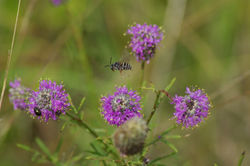
Join us 26 June 2021 for the Seventh Annual Bee Hunt!
The Longspur Prairie Fund Bee Hunt is one part research project and one part family prairie field trip! Join us and bee scholar Dr. D. Bryan Bishop (Associate Professor, Concordia College) for our annual bee hunt on Ulen Prairie.
THIS EVENT IS FREE TO THE PUBLIC, BUT PLEASE REGISTER HERE!
(Rain Date is Sunday, 27 June.)
So, what's a "bee hunt"?
During a bee hunt, you will use a camera to "capture" bees in their native environment. A bee hunt is a great way to learn about pollinator ecology and other aspects of the Red River Valley's natural history. By following and engaging the scientific method, you will collect, contribute, and learn from real-world biological data. Most importantly, bee hunting is a blast!
What's the schedule like for the bee hunt?
1015 - Convene at LPF: Ulen Prairie (PDF Map and Directions.)
1030 - BEE HUNT!
1130 - Photo download!
12:00 - Send off!
Why is bee hunting important?
A bee hunt is a great introduction to biological field science. Field science is challenging and rewarding. One of the most important aspects of field work is the accurate and consistent data collection and observation. One of the bee hunt's main purposes is to help young scientists and other participants develop an understanding of these scientific principles. In order for it to have real value for bee experts, a bee hunt is dependent upon good data collection. Scientists need to know: 1) where the bees were found; 2) when the bees where found; 3) the habitat type and weather conditions within which bees were found; and most importantly 4) on which plant the bees were found. During the bee hunt, our resident bee scholar, Dr. D. Bryan Bishop, will take care of the first three of these. The fourth part -- finding bees! -- is where we need your help!
How do you "hunt bees"?
With your camera! In order to hunt bees with your camera, your camera must be able to pass the "dime test." It's easy! Take a picture of a dime. If you can read "E PLURIBUS UNUM" on your photograph, then your camera passes the dime test!
My camera is ready! Now what?
Once you've got the dime test down there are five easy steps to bee hunting:
1) Find a bee or other insect. (Butterflies, bees, wasps, ladybugs are top priority!)
2) When you find your target, take a close up picture of the bee or insect.
3) Next, take a picture of the plant's stem and leaves.
4) Next, take a picture of the whole plant that its resting on.
5) Once you have successfully hunted fifteen different bees or insects, return to Dr. Bishop to upload your data.
**If you are using a phone to hunt bees, please download the iNaturalist app, HERE, to upload your
documentation of bees.**
Is there an age limit for bee hunters?
There is no age limit for the bee hunt. Come one, come all!
What should I bring to the bee hunt?
1. Water
2. Long sleeved shirts. Full pants. Head protection. Mask.
3. Bug spray and sun screen.
4. Camera or phone.
5. Bee Hunt Instructions, BELOW.
6. Your sense of adventure!
That's it! You're all set to become a bee hunter!
The following documents will be of use to all bee hunters:
Bee Hunt Instructions (PDF Download)
 |  |  |  |  |  |  |
|---|---|---|---|---|---|---|
 |  |  |  |  |  |  |
 |  |  |  |  |

